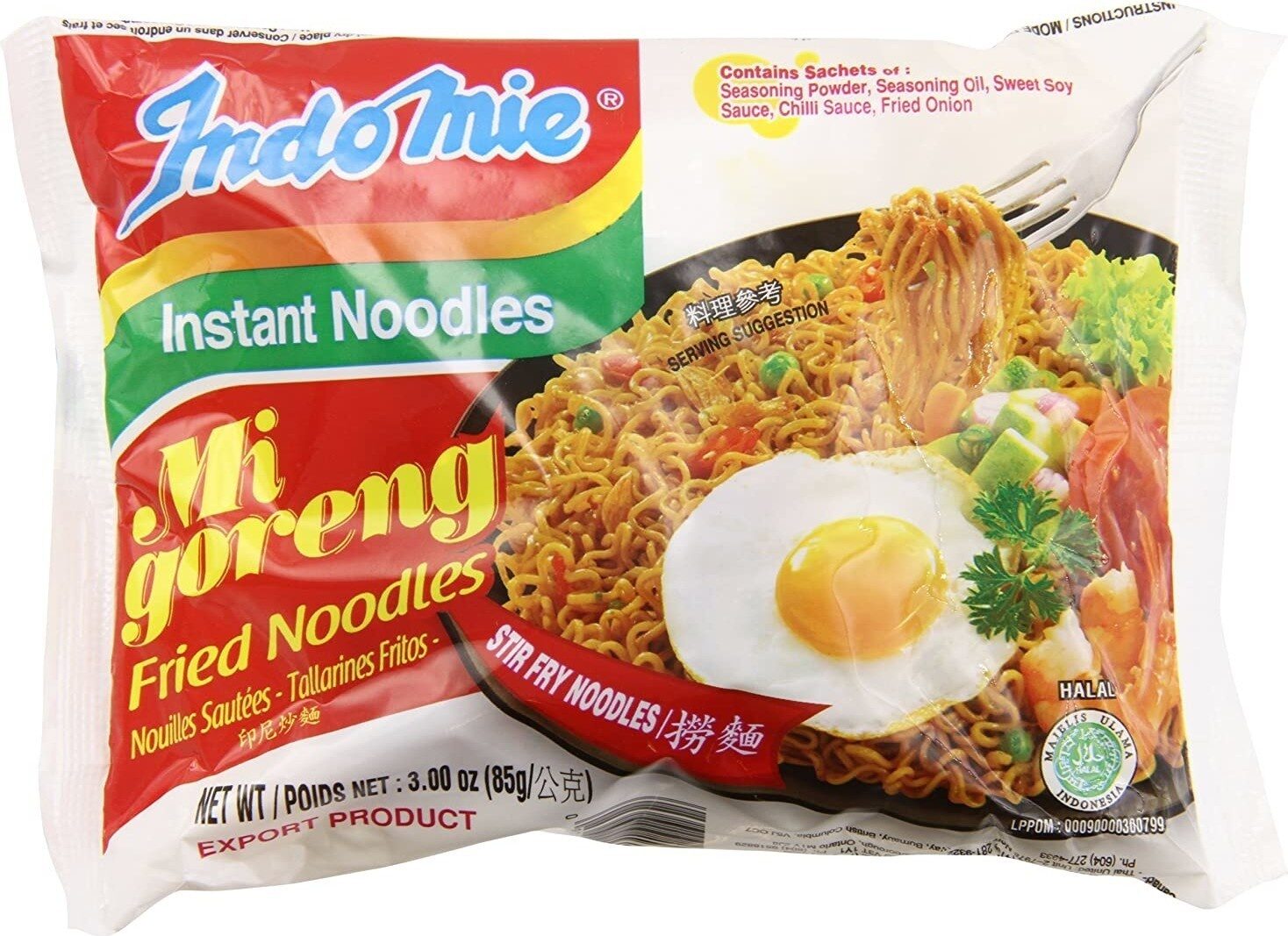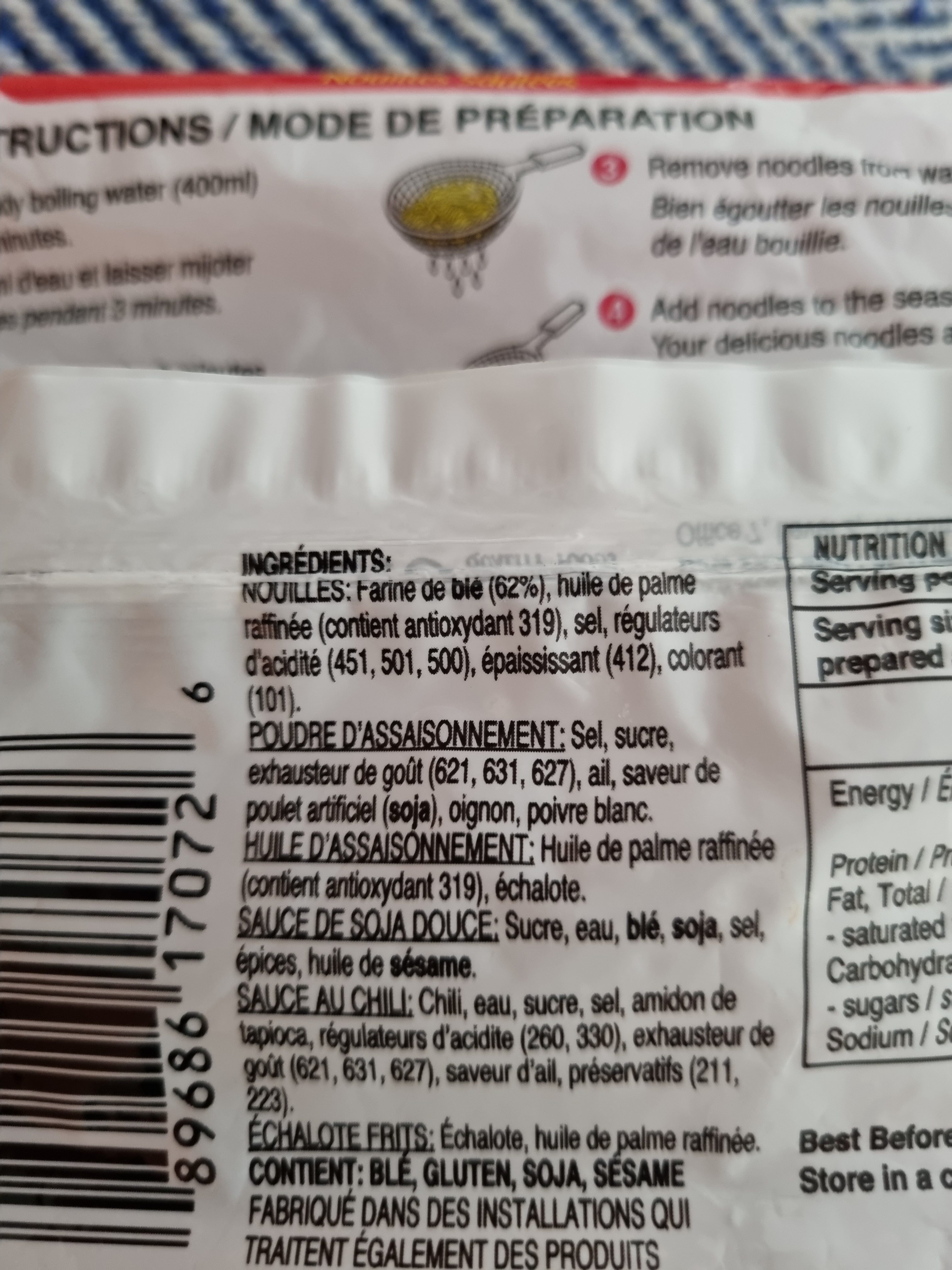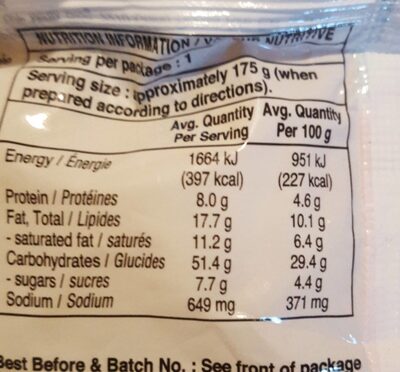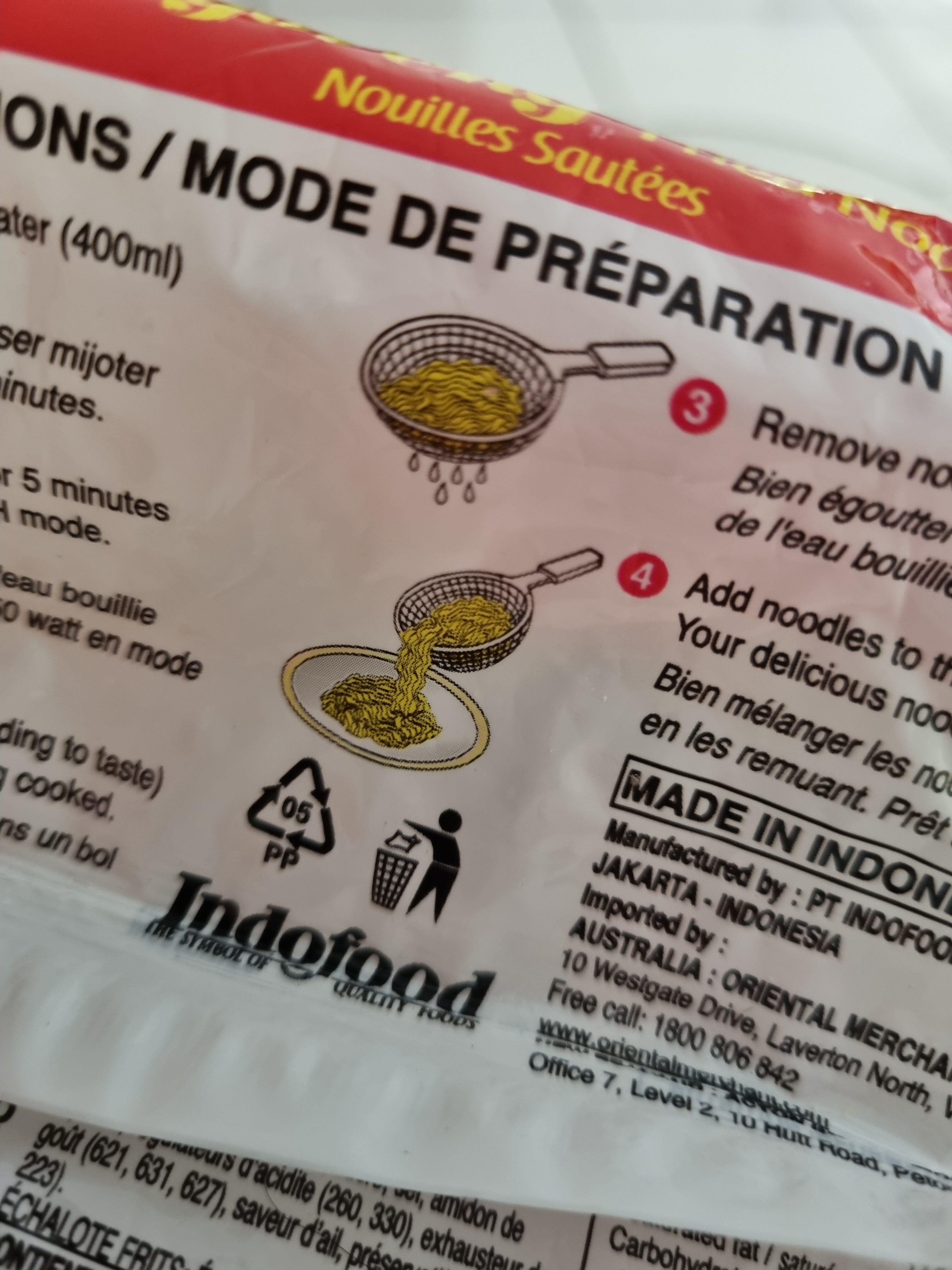Help us make food transparency the norm!
As a non-profit organization, we depend on your donations to continue informing consumers around the world about what they eat.
The food revolution starts with you!
Indo mie mi goreng instant noodle - IndofoodIndomie - 85g
Indo mie mi goreng instant noodle - IndofoodIndomie - 85g
Barcode: 0089686170726 (EAN / EAN-13) 089686170726 (UPC / UPC-A)
Quantity: 85g
Packaging: Plastic
Brands: IndofoodIndomie
Categories: Plant-based foods and beverages, Plant-based foods, Cereals and potatoes, Cereals and their products, Dried products, Pastas, Dried products to be rehydrated, Noodles, Instant noodles, Asian Foods, Indonesian Foods
Labels, certifications, awards:
Halal
Origin of ingredients: Indonesia
Manufacturing or processing places: Indonesia
Link to the product page on the official site of the producer: http://www.indomie.com/Product/Category/...
Stores: Coles, Woolworths, Indomaret, Alfamart, Giant, Carrefour
Matching with your preferences
Health
Ingredients
-
61 ingredients
noodles : wheat flour (62%), refined palm oil (contains antioxidant 319), salt, acidity regulators (451, 501, 500), thickener (412), colour (101), seasoning powder: salt, sugar, flavour enhancers (621, 631, 627), garlic powder, onion powder, yeast extract, artificial flavour, pepper, anticaking agent (551), seasoning oil: refined palm oil (contains antioxidant 319), onion, sweet soy sauce: sugar, water, salt, wheat, soy bean, spices, sesame oil, chilli sauce: chilli, water, sugar, salt, tapioca starch, acidity regulators (260, 330), herbs, flavour enhancers (621, 627,e631), flavours, preservatives (211, 223), fried onion: onion, refined palm oil (contains antioxidant 319), allergen: contains wheat, contains sesame, contains soyAllergens: Gluten, Sesame seeds, Soybeans
Food processing
-
Ultra processed foods
Elements that indicate the product is in the 4 - Ultra processed food and drink products group:
- Additive: E101 - Riboflavin
- Additive: E412 - Guar gum
- Additive: E451 - Triphosphates
- Additive: E551 - Silicon dioxide
- Additive: E621 - Monosodium glutamate
- Additive: E627 - Disodium guanylate
- Additive: E631 - Disodium inosinate
- Ingredient: Colour
- Ingredient: Flavour enhancer
- Ingredient: Flavouring
- Ingredient: Thickener
Food products are classified into 4 groups according to their degree of processing:
- Unprocessed or minimally processed foods
- Processed culinary ingredients
- Processed foods
- Ultra processed foods
The determination of the group is based on the category of the product and on the ingredients it contains.
Additives
-
E101 - Riboflavin
Riboflavin: Riboflavin, also known as vitamin B2, is a vitamin found in food and used as a dietary supplement. Food sources include eggs, green vegetables, milk and other dairy product, meat, mushrooms, and almonds. Some countries require its addition to grains. As a supplement it is used to prevent and treat riboflavin deficiency and prevent migraines. It may be given by mouth or injection.It is nearly always well tolerated. Normal doses are safe during pregnancy. Riboflavin is in the vitamin B group. It is required by the body for cellular respiration.Riboflavin was discovered in 1920, isolated in 1933, and first made in 1935. It is on the World Health Organization's List of Essential Medicines, the most effective and safe medicines needed in a health system. Riboflavin is available as a generic medication and over the counter. In the United States a month of supplements costs less than 25 USD.Source: Wikipedia
-
E211 - Sodium benzoate
Sodium benzoate: Sodium benzoate is a substance which has the chemical formula NaC7H5O2. It is a widely used food preservative, with an E number of E211. It is the sodium salt of benzoic acid and exists in this form when dissolved in water. It can be produced by reacting sodium hydroxide with benzoic acid.Source: Wikipedia
-
E223 - Sodium metabisulphite
Sodium metabisulfite: Sodium metabisulfite or sodium pyrosulfite -IUPAC spelling; Br. E. sodium metabisulphite or sodium pyrosulphite- is an inorganic compound of chemical formula Na2S2O5. The substance is sometimes referred to as disodium metabisulfite. It is used as a disinfectant, antioxidant, and preservative agent.Source: Wikipedia
-
E260 - Acetic acid
Acetic acid: Acetic acid , systematically named ethanoic acid , is a colorless liquid organic compound with the chemical formula CH3COOH -also written as CH3CO2H or C2H4O2-. When undiluted, it is sometimes called glacial acetic acid. Vinegar is no less than 4% acetic acid by volume, making acetic acid the main component of vinegar apart from water. Acetic acid has a distinctive sour taste and pungent smell. In addition to household vinegar, it is mainly produced as a precursor to polyvinyl acetate and cellulose acetate. It is classified as a weak acid since it only partially dissociates in solution, but concentrated acetic acid is corrosive and can attack the skin. Acetic acid is the second simplest carboxylic acid -after formic acid-. It consists of a methyl group attached to a carboxyl group. It is an important chemical reagent and industrial chemical, used primarily in the production of cellulose acetate for photographic film, polyvinyl acetate for wood glue, and synthetic fibres and fabrics. In households, diluted acetic acid is often used in descaling agents. In the food industry, acetic acid is controlled by the food additive code E260 as an acidity regulator and as a condiment. In biochemistry, the acetyl group, derived from acetic acid, is fundamental to all forms of life. When bound to coenzyme A, it is central to the metabolism of carbohydrates and fats. The global demand for acetic acid is about 6.5 million metric tons per year -Mt/a-, of which approximately 1.5 Mt/a is met by recycling; the remainder is manufactured from methanol. Vinegar is mostly dilute acetic acid, often produced by fermentation and subsequent oxidation of ethanol.Source: Wikipedia
-
E319 - Tertiary-butylhydroquinone (tbhq)
Tert-Butylhydroquinone: tert-Butylhydroquinone -TBHQ, tertiary butylhydroquinone- is a synthetic aromatic organic compound which is a type of phenol. It is a derivative of hydroquinone, substituted with a tert-butyl group.Source: Wikipedia
-
E330 - Citric acid
Citric acid is a natural organic acid found in citrus fruits such as lemons, oranges, and limes.
It is widely used in the food industry as a flavor enhancer, acidulant, and preservative due to its tart and refreshing taste.
Citric acid is safe for consumption when used in moderation and is considered a generally recognized as safe (GRAS) food additive by regulatory agencies worldwide.
-
E412 - Guar gum
Guar gum (E412) is a natural food additive derived from guar beans.
This white, odorless powder is valued for its remarkable thickening and stabilizing properties, making it a common ingredient in various food products, including sauces, dressings, and ice creams.
When used in moderation, guar gum is considered safe for consumption, with no known adverse health effects.
-
E451 - Triphosphates
Sodium triphosphate: Sodium triphosphate -STP-, also sodium tripolyphosphate -STPP-, or tripolyphosphate -TPP-,- is an inorganic compound with formula Na5P3O10. It is the sodium salt of the polyphosphate penta-anion, which is the conjugate base of triphosphoric acid. It is produced on a large scale as a component of many domestic and industrial products, especially detergents. Environmental problems associated with eutrophication are attributed to its widespread use.Source: Wikipedia
-
E500 - Sodium carbonates
Sodium carbonates (E500) are compounds commonly used in food preparation as leavening agents, helping baked goods rise by releasing carbon dioxide when they interact with acids.
Often found in baking soda, they regulate the pH of food, preventing it from becoming too acidic or too alkaline. In the culinary world, sodium carbonates can also enhance the texture and structure of foods, such as noodles, by modifying the gluten network.
Generally recognized as safe, sodium carbonates are non-toxic when consumed in typical amounts found in food.
-
E501 - Potassium carbonates
Potassium carbonate: Potassium carbonate -K2CO3- is a white salt, which is soluble in water -insoluble in ethanol- and forms a strongly alkaline solution. It can be made as the product of potassium hydroxide's absorbent reaction with carbon dioxide. It is deliquescent, often appearing a damp or wet solid. Potassium carbonate is used in the production of soap and glass.Source: Wikipedia
-
E551 - Silicon dioxide
Silicon dioxide: Silicon dioxide, also known as silica, silicic acid or silicic acid anydride is an oxide of silicon with the chemical formula SiO2, most commonly found in nature as quartz and in various living organisms. In many parts of the world, silica is the major constituent of sand. Silica is one of the most complex and most abundant families of materials, existing as a compound of several minerals and as synthetic product. Notable examples include fused quartz, fumed silica, silica gel, and aerogels. It is used in structural materials, microelectronics -as an electrical insulator-, and as components in the food and pharmaceutical industries. Inhaling finely divided crystalline silica is toxic and can lead to severe inflammation of the lung tissue, silicosis, bronchitis, lung cancer, and systemic autoimmune diseases, such as lupus and rheumatoid arthritis. Uptake of amorphous silicon dioxide, in high doses, leads to non-permanent short-term inflammation, where all effects heal.Source: Wikipedia
-
E621 - Monosodium glutamate
Monosodium glutamate: Monosodium glutamate -MSG, also known as sodium glutamate- is the sodium salt of glutamic acid, one of the most abundant naturally occurring non-essential amino acids. Glutamic acid is found naturally in tomatoes, grapes, cheese, mushrooms and other foods.MSG is used in the food industry as a flavor enhancer with an umami taste that intensifies the meaty, savory flavor of food, as naturally occurring glutamate does in foods such as stews and meat soups. It was first prepared in 1908 by Japanese biochemist Kikunae Ikeda, who was trying to isolate and duplicate the savory taste of kombu, an edible seaweed used as a base for many Japanese soups. MSG as a flavor enhancer balances, blends, and rounds the perception of other tastes.The U.S. Food and Drug Administration has given MSG its generally recognized as safe -GRAS- designation. A popular belief is that large doses of MSG can cause headaches and other feelings of discomfort, known as "Chinese restaurant syndrome," but double-blind tests fail to find evidence of such a reaction. The European Union classifies it as a food additive permitted in certain foods and subject to quantitative limits. MSG has the HS code 29224220 and the E number E621.Source: Wikipedia
-
E627 - Disodium guanylate
Disodium guanylate: Disodium guanylate, also known as sodium 5'-guanylate and disodium 5'-guanylate, is a natural sodium salt of the flavor enhancing nucleotide guanosine monophosphate -GMP-. Disodium guanylate is a food additive with the E number E627. It is commonly used in conjunction with glutamic acid. As it is a fairly expensive additive, it is not used independently of glutamic acid; if disodium guanylate is present in a list of ingredients but MSG does not appear to be, it is likely that glutamic acid is provided as part of another ingredient such as a processed soy protein complex. It is often added to foods in conjunction with disodium inosinate; the combination is known as disodium 5'-ribonucleotides. Disodium guanylate is produced from dried seaweed and is often added to instant noodles, potato chips and other snacks, savory rice, tinned vegetables, cured meats, and packaged soup.Source: Wikipedia
-
E631 - Disodium inosinate
Disodium inosinate: Disodium inosinate -E631- is the disodium salt of inosinic acid with the chemical formula C10H11N4Na2O8P. It is used as a food additive and often found in instant noodles, potato chips, and a variety of other snacks. Although it can be obtained from bacterial fermentation of sugars, it is often commercially prepared from animal sources.Source: Wikipedia
Ingredients analysis
-
Palm oil
Ingredients that contain palm oil: Refined palm oil, Refined palm oil, Refined palm oil
-
Vegan status unknown
Unrecognized ingredients: Contains-antioxidant-319, 451, 501, 500, 412, 101, 621, 631, 627, 551, Seasoning-oil, Contains-antioxidant-319, Chilli-sauce, 260, 330, 621, 627, 211, 223, Fried onion, Contains-antioxidant-319Some ingredients could not be recognized.
We need your help!
You can help us recognize more ingredients and better analyze the list of ingredients for this product and others:
- Edit this product page to correct spelling mistakes in the ingredients list, and/or to remove ingredients in other languages and sentences that are not related to the ingredients.
- Add new entries, synonyms or translations to our multilingual lists of ingredients, ingredient processing methods, and labels.
If you would like to help, join the #ingredients channel on our Slack discussion space and/or learn about ingredients analysis on our wiki. Thank you!
-
Vegetarian status unknown
Unrecognized ingredients: Contains-antioxidant-319, 451, 501, 500, 412, 101, 621, 631, 627, 551, Seasoning-oil, Contains-antioxidant-319, Chilli-sauce, 260, 330, 621, 627, 211, 223, Fried onion, Contains-antioxidant-319Some ingredients could not be recognized.
We need your help!
You can help us recognize more ingredients and better analyze the list of ingredients for this product and others:
- Edit this product page to correct spelling mistakes in the ingredients list, and/or to remove ingredients in other languages and sentences that are not related to the ingredients.
- Add new entries, synonyms or translations to our multilingual lists of ingredients, ingredient processing methods, and labels.
If you would like to help, join the #ingredients channel on our Slack discussion space and/or learn about ingredients analysis on our wiki. Thank you!
-
Details of the analysis of the ingredients
We need your help!
Some ingredients could not be recognized.
We need your help!
You can help us recognize more ingredients and better analyze the list of ingredients for this product and others:
- Edit this product page to correct spelling mistakes in the ingredients list, and/or to remove ingredients in other languages and sentences that are not related to the ingredients.
- Add new entries, synonyms or translations to our multilingual lists of ingredients, ingredient processing methods, and labels.
If you would like to help, join the #ingredients channel on our Slack discussion space and/or learn about ingredients analysis on our wiki. Thank you!
: noodles (wheat flour 62%), refined palm oil (contains antioxidant 319), salt, acidity regulators (451, 501, 500), thickener (412), colour (101), seasoning (salt), sugar, flavour enhancers (621, 631, 627), garlic, onion, yeast extract, artificial flavour, pepper, anticaking agent (551), seasoning oil (refined palm oil (contains antioxidant 319)), onion, sweet soy sauce (sugar), water, salt, wheat, soy bean, spices, sesame oil, chilli sauce (chilli), water, sugar, salt, tapioca starch, acidity regulators (260, 330), herbs, flavour enhancers (621, 627, e631), flavours, preservatives (211, 223), fried onion (onion), refined palm oil (contains antioxidant 319)- noodles -> en:noodle - vegan: maybe - vegetarian: maybe - percent_min: 62 - percent_max: 62
- wheat flour -> en:wheat-flour - vegan: yes - vegetarian: yes - ciqual_proxy_food_code: 9410 - percent_min: 62 - percent: 62 - percent_max: 62
- refined palm oil -> en:refined-palm-oil - vegan: yes - vegetarian: yes - from_palm_oil: yes - ciqual_food_code: 16150 - percent_min: 6.47714285714308 - percent_max: 38
- contains antioxidant 319 -> en:contains-antioxidant-319 - percent_min: 6.47714285714308 - percent_max: 38
- salt -> en:salt - vegan: yes - vegetarian: yes - ciqual_food_code: 11058 - percent_min: 0 - percent_max: 0.92714285714285
- acidity regulators -> en:acidity-regulator - percent_min: 0 - percent_max: 0.92714285714285
- 451 -> en:451 - percent_min: 0 - percent_max: 0.92714285714285
- 501 -> en:501 - percent_min: 0 - percent_max: 0.463571428571425
- 500 -> en:500 - percent_min: 0 - percent_max: 0.309047619047617
- thickener -> en:thickener - percent_min: 0 - percent_max: 0.92714285714285
- 412 -> en:412 - percent_min: 0 - percent_max: 0.92714285714285
- colour -> en:colour - percent_min: 0 - percent_max: 0.92714285714285
- 101 -> en:101 - percent_min: 0 - percent_max: 0.92714285714285
- seasoning -> en:coating - vegan: maybe - vegetarian: maybe - percent_min: 0 - percent_max: 0.92714285714285
- salt -> en:salt - vegan: yes - vegetarian: yes - ciqual_food_code: 11058 - percent_min: 0 - percent_max: 0.92714285714285
- sugar -> en:sugar - vegan: yes - vegetarian: yes - ciqual_proxy_food_code: 31016 - percent_min: 0 - percent_max: 0.92714285714285
- flavour enhancers -> en:flavour-enhancer - percent_min: 0 - percent_max: 0.92714285714285
- 621 -> en:621 - percent_min: 0 - percent_max: 0.92714285714285
- 631 -> en:631 - percent_min: 0 - percent_max: 0.463571428571425
- 627 -> en:627 - percent_min: 0 - percent_max: 0.309047619047617
- garlic -> en:garlic - vegan: yes - vegetarian: yes - ciqual_food_code: 11000 - percent_min: 0 - percent_max: 0.92714285714285
- onion -> en:onion - vegan: yes - vegetarian: yes - ciqual_food_code: 20034 - percent_min: 0 - percent_max: 0.92714285714285
- yeast extract -> en:yeast-extract - vegan: yes - vegetarian: yes - percent_min: 0 - percent_max: 0.92714285714285
- artificial flavour -> en:artificial-flavouring - vegan: maybe - vegetarian: maybe - percent_min: 0 - percent_max: 0.92714285714285
- pepper -> en:pepper - vegan: yes - vegetarian: yes - percent_min: 0 - percent_max: 0.92714285714285
- anticaking agent -> en:anti-caking-agent - percent_min: 0 - percent_max: 0.92714285714285
- 551 -> en:551 - percent_min: 0 - percent_max: 0.92714285714285
- seasoning oil -> en:seasoning-oil - percent_min: 0 - percent_max: 0.92714285714285
- refined palm oil -> en:refined-palm-oil - vegan: yes - vegetarian: yes - from_palm_oil: yes - ciqual_food_code: 16150 - percent_min: 0 - percent_max: 0.92714285714285
- contains antioxidant 319 -> en:contains-antioxidant-319 - percent_min: 0 - percent_max: 0.92714285714285
- refined palm oil -> en:refined-palm-oil - vegan: yes - vegetarian: yes - from_palm_oil: yes - ciqual_food_code: 16150 - percent_min: 0 - percent_max: 0.92714285714285
- onion -> en:onion - vegan: yes - vegetarian: yes - ciqual_food_code: 20034 - percent_min: 0 - percent_max: 0.92714285714285
- sweet soy sauce -> en:sweet-soy-sauce - vegan: maybe - vegetarian: maybe - ciqual_food_code: 11104 - percent_min: 0 - percent_max: 0.92714285714285
- sugar -> en:sugar - vegan: yes - vegetarian: yes - ciqual_proxy_food_code: 31016 - percent_min: 0 - percent_max: 0.92714285714285
- water -> en:water - vegan: yes - vegetarian: yes - ciqual_food_code: 18066 - percent_min: 0 - percent_max: 0.92714285714285
- salt -> en:salt - vegan: yes - vegetarian: yes - ciqual_food_code: 11058 - percent_min: 0 - percent_max: 0.92714285714285
- wheat -> en:wheat - vegan: yes - vegetarian: yes - ciqual_proxy_food_code: 9410 - percent_min: 0 - percent_max: 0.92714285714285
- soy bean -> en:soya-bean - vegan: yes - vegetarian: yes - ciqual_food_code: 20901 - percent_min: 0 - percent_max: 0.92714285714285
- spices -> en:spice - vegan: yes - vegetarian: yes - percent_min: 0 - percent_max: 0.92714285714285
- sesame oil -> en:sesame-oil - vegan: yes - vegetarian: yes - from_palm_oil: no - ciqual_food_code: 17400 - percent_min: 0 - percent_max: 0.92714285714285
- chilli sauce -> en:chilli-sauce - percent_min: 0 - percent_max: 0.92714285714285
- chilli -> en:chili-pepper - vegan: yes - vegetarian: yes - ciqual_food_code: 20151 - percent_min: 0 - percent_max: 0.92714285714285
- water -> en:water - vegan: yes - vegetarian: yes - ciqual_food_code: 18066 - percent_min: 0 - percent_max: 0.92714285714285
- sugar -> en:sugar - vegan: yes - vegetarian: yes - ciqual_proxy_food_code: 31016 - percent_min: 0 - percent_max: 0.92714285714285
- salt -> en:salt - vegan: yes - vegetarian: yes - ciqual_food_code: 11058 - percent_min: 0 - percent_max: 0.92714285714285
- tapioca starch -> en:tapioca - vegan: yes - vegetarian: yes - ciqual_proxy_food_code: 9510 - percent_min: 0 - percent_max: 0.92714285714285
- acidity regulators -> en:acidity-regulator - percent_min: 0 - percent_max: 0.92714285714285
- 260 -> en:260 - percent_min: 0 - percent_max: 0.92714285714285
- 330 -> en:330 - percent_min: 0 - percent_max: 0.463571428571425
- herbs -> en:herb - vegan: yes - vegetarian: yes - percent_min: 0 - percent_max: 0.92714285714285
- flavour enhancers -> en:flavour-enhancer - percent_min: 0 - percent_max: 0.92714285714285
- 621 -> en:621 - percent_min: 0 - percent_max: 0.92714285714285
- 627 -> en:627 - percent_min: 0 - percent_max: 0.463571428571425
- e631 -> en:e631 - vegan: maybe - vegetarian: maybe - percent_min: 0 - percent_max: 0.309047619047617
- flavours -> en:flavouring - vegan: maybe - vegetarian: maybe - percent_min: 0 - percent_max: 0.92714285714285
- preservatives -> en:preservative - percent_min: 0 - percent_max: 0.92714285714285
- 211 -> en:211 - percent_min: 0 - percent_max: 0.92714285714285
- 223 -> en:223 - percent_min: 0 - percent_max: 0.463571428571425
- fried onion -> en:fried-onion - percent_min: 0 - percent_max: 0.92714285714285
- onion -> en:onion - vegan: yes - vegetarian: yes - ciqual_food_code: 20034 - percent_min: 0 - percent_max: 0.92714285714285
- refined palm oil -> en:refined-palm-oil - vegan: yes - vegetarian: yes - from_palm_oil: yes - ciqual_food_code: 16150 - percent_min: 0 - percent_max: 0.92714285714285
- contains antioxidant 319 -> en:contains-antioxidant-319 - percent_min: 0 - percent_max: 0.92714285714285
-
Nutrition facts
Nutrition facts As sold
for 100 g / 100 mlCompared to: Instant noodles Energy 951 kj
(227 kcal)+1% Fat 10.114 g +27% Saturated fat 6.4 g +73% Carbohydrates 29.371 g -1% Sugars 4.4 g +124% Fiber 3.529 g +154% Proteins 4.571 g -4% Salt 0.927 g -48% Fruits‚ vegetables‚ nuts and rapeseed‚ walnut and olive oils (estimate from ingredients list analysis) 1.854 %
Environment
-
Eco-Score C - Moderate environmental impact
⚠ ️The full impact of transportation to your country is currently unknown.The Eco-Score is an experimental score that summarizes the environmental impacts of food products.→ The Eco-Score was initially developped for France and it is being extended to other European countries. The Eco-Score formula is subject to change as it is regularly improved to make it more precise and better suited to each country.Life cycle analysis
-
Average impact of products of the same category: A (Score: 82/100)
Category: Asian noodles, flavoured, dehydrated
Category: Asian noodles, flavoured, dehydrated
- PEF environmental score: 0.26 (the lower the score, the lower the impact)
- including impact on climate change: 1.67 kg CO2 eq/kg of product
Stage Impact Agriculture
65.5 %Processing
20.6 %Packaging
8.7 %Transportation
3.5 %Distribution
1.8 %Consumption
0.0 %
Bonuses and maluses
-
Origins of ingredients with a high impact
Malus:
Environmental policy: -5
Transportation: 0
Origin of the product and/or its ingredients % of ingredients Impact Indonesia 100 %High
-
Ingredients that threatens species
Malus: -10
Contains palm oil
Tropical forests in Asia, Africa and Latin America are destroyed to create and expand oil palm tree plantations. The deforestation contributes to climate change, and it endangers species such as the orangutan, the pigmy elephant and the Sumatran rhino.
-
Packaging with a medium impact
Malus: -10
Shape Material Recycling Impact Unknown Plastic High ⚠ ️ The information about the packaging of this product is not sufficiently precise (exact shapes and materials of all components of the packaging).⚠ ️ For a more precise calculation of the Eco-Score, you can modify the product page and add them.
If you are the manufacturer of this product, you can send us the information with our free platform for producers.
Eco-Score for this product
-
Impact for this product: C (Score: 57/100)
Product: Indo mie mi goreng instant noodle - IndofoodIndomie - 85g
Life cycle analysis score: 82
Sum of bonuses and maluses: -20
Final score: 57/100
-
Carbon footprint
-
Equal to driving 0.9 km in a petrol car
167 g CO² per 100g of product
The carbon emission figure comes from ADEME's Agribalyse database, for the category: Asian noodles, flavoured, dehydrated (Source: ADEME Agribalyse Database)
Stage Impact Agriculture
61.0 %Processing
14.9 %Packaging
16.3 %Transportation
6.8 %Distribution
1.0 %Consumption
0.0 %
Packaging
-
Packaging with a medium impact
-
Packaging parts
(Plastic)
-
Packaging materials
Material % Packaging weight Packaging weight per 100 g of product Plastic
-
Transportation
-
Origins of ingredients
Origins of ingredients with a high impact
Origin of the product and/or its ingredients % of ingredients Impact Indonesia 100 %High
Threatened species
-
Contains palm oil
Drives deforestation and threatens species such as the orangutan
Tropical forests in Asia, Africa and Latin America are destroyed to create and expand oil palm tree plantations. The deforestation contributes to climate change, and it endangers species such as the orangutan, the pigmy elephant and the Sumatran rhino.
Report a problem
-
Incomplete or incorrect information?
Category, labels, ingredients, allergens, nutritional information, photos etc.
If the information does not match the information on the packaging, please complete or correct it. Open Food Facts is a collaborative database, and every contribution is useful for all.
Data sources
Product added on by foodorigins
Last edit of product page on by tspk.
Product page also edited by deorcregnboga, ecoscore-impact-estimator, halal-app-chakib, inf, kiliweb, kp757, off.ec5873635bf7635774ebc4e7395fd2e, openfoodfacts-contributors, packbot, tbound2, upcbot, veganeamos, yuka.UUtZNU5hWmRuOGdWeDgwOTBES0UxL2N2eTQyR2ZHcXRLYklESVE9PQ, yuka.sY2b0xO6T85zoF3NwEKvlndlSsKG_irHBjPRx0C2-uivcJvqa8tQv9CmYqs, yuka.sY2b0xO6T85zoF3NwEKvlnxFfYCEpjubOhbus1SI3NyoHL_MSPhPv6XDPKg, yukafix.










